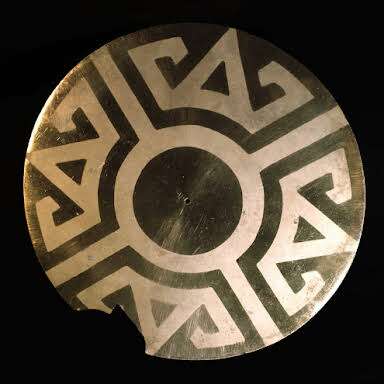
Rotating disk
Nariño Plateau. Late Period. 600/1700
Title: Rotating disk
Creator: Nariño Plateau – Late Period
Date: 600/1700
Physical Dimensions: w150 mm
Type: Goldwork
Location: People and Gold in Pre-Hispanic Colombia
Technique: Hammered tumbaga with depletion gilding
Finding: Colombia, Nariño, Pupiales
Accession number: O21222
Unique for their careful manufacture, and their unknown use, the spinning discs of Nariño are one of the riddles in American archaeology. Their motives play with the symmetry related to the central hole, either exclusively with the glossing always crossing the centre, either by rotating one same motive, once, twice, four, five, six or eight times. We can add “infinite times” to this restrained list if we admit with the mathematicians that the circles –the only decoration on some of the discs– are polygons with infinite faces.
The golden and burnished surface of this disc was partially covered in wax or mopa-mopa (Elaeagia utilis, Wedd) resins, and dipped in acid: the protected parts preserved their shine, while those exposed to the corrosive agent took a more matt finish. Similar techniques of “resist painting” were used in the Nariño region to decorate ceramics and wooden objects.
Why would a society at the top of the Andes be so interested in perfection of the shapes? First we must understand that these societies were very skilled weavers, and you require a good knowledge of mathematics to knit. A blanket is the equivalent of the Orthogonal Cartesian System with lines and straight angles, rows and columns; a round basket allows for the same rotating designs we see in the discs. These, more than a basket, would require perfect symmetry if we consider they were made to watch them spin, suspended from a cord from the centre hole frequently showing signs of wear due to friction on the bottom face of the object. When the identical shiny shapes would spin they would produce the hypnotic effects typically used in shamanic religions. EL/CP